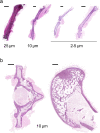Spatial quantitation of antibiotics in bone tissue compartments by laser-capture microdissection coupled with UHPLC-tandem mass spectrometry
- PMID: 35945288
- PMCID: PMC9436889
- DOI: 10.1007/s00216-022-04257-3
Spatial quantitation of antibiotics in bone tissue compartments by laser-capture microdissection coupled with UHPLC-tandem mass spectrometry
Abstract
Bones are the site of multiple diseases requiring chemotherapy, including cancer, arthritis, osteoporosis and infections. Yet limited methodologies are available to investigate the spatial distribution and quantitation of small molecule drugs in bone compartments, due to the difficulty of sectioning undecalcified bones and the interference of decalcification methods with spatially resolved drug quantitation. To measure drug concentrations in distinct anatomical bone regions, we have developed a workflow that enables spatial quantitation of thin undecalcified bone sections by laser-capture microdissection coupled to HPLC/tandem mass spectrometry, and spatial mapping on adjacent sections by mass spectrometry imaging. The adhesive film and staining methods were optimized to facilitate histology staining on the same sections used for mass spectrometry image acquisition, revealing drug accumulation in the underlying bone tissue architecture, for the first time. Absolute spatial concentrations of rifampicin, bedaquiline, doxycycline, vancomycin and several of their active metabolites are shown for both small rodent bones and larger rabbit bones that more closely resemble human bone density. Overlaid MALDI mass spectrometry images of drugs and histology staining enabled the generation of semi-quantitative data from regions of interest within anatomical bone compartments. These data correlated with absolute drug concentrations determined by HPLC-MS/MS in laser-capture microdissection samples. Collectively, these techniques enable semi- and fully quantitative drug distribution investigations within bone tissue compartments for the first time. Our workflow can be translated to image and quantify not only drugs but also biomarkers of disease to investigate drug penetration as well as mechanisms underlying bone disorders.
Keywords: Antibiotics; Bone penetration; Laser-capture microdissection; MALDI mass spectrometry imaging; Spatial quantitation.
© 2022. The Author(s).
Conflict of interest statement
The authors declare no competing interests.
Figures





Similar articles
-
Mass Spectrometry Imaging, Laser Capture Microdissection, and LC-MS/MS of the Same Tissue Section.J Proteome Res. 2017 Aug 4;16(8):2993-3001. doi: 10.1021/acs.jproteome.7b00284. Epub 2017 Jul 5. J Proteome Res. 2017. PMID: 28648079
-
Absolute Quantification of Rifampicin by MALDI Imaging Mass Spectrometry Using Multiple TOF/TOF Events in a Single Laser Shot.J Am Soc Mass Spectrom. 2017 Jan;28(1):136-144. doi: 10.1007/s13361-016-1501-2. Epub 2016 Sep 21. J Am Soc Mass Spectrom. 2017. PMID: 27655354 Free PMC article.
-
Online, Absolute Quantitation of Propranolol from Spatially Distinct 20- and 40-μm Dissections of Brain, Liver, and Kidney Thin Tissue Sections by Laser Microdissection-Liquid Vortex Capture-Mass Spectrometry.Anal Chem. 2016 Jun 7;88(11):6026-34. doi: 10.1021/acs.analchem.6b01155. Epub 2016 May 23. Anal Chem. 2016. PMID: 27214103
-
Combining laser capture microdissection and proteomics techniques.Methods Mol Biol. 2008;428:159-78. doi: 10.1007/978-1-59745-117-8_9. Methods Mol Biol. 2008. PMID: 18287773 Review.
-
Tissue profiling by mass spectrometry: a review of methodology and applications.Mol Cell Proteomics. 2005 Apr;4(4):394-401. doi: 10.1074/mcp.R500006-MCP200. Epub 2005 Jan 26. Mol Cell Proteomics. 2005. PMID: 15677390 Review.
Cited by
-
Trans-eyelid distribution of epinastine to the conjunctiva following eyelid application in rabbits.Jpn J Ophthalmol. 2024 Sep;68(5):594-602. doi: 10.1007/s10384-024-01070-6. Epub 2024 May 25. Jpn J Ophthalmol. 2024. PMID: 38795193 Free PMC article.
References
-
- Dornbusch K. The detection of doxycycline activity in human bone. Scand J Infect Dis Suppl. 1976;9:47–53. - PubMed
-
- Landersdorfer CB, Bulitta JB, Nation RL, Sörgel F. Pharmacokinetics and Pharmacodynamics of Antibiotics in Bone. In: Zimmerli W, editor. Bone and joint infections: from microbiology to diagnostics and treatment. Second edition: Wiley Blackwell; 2021. pp. 81–98.
-
- Renz N, Margaryan D, Trampuz A. Diagnostic approach in bone and joint infections. In: Zimmerli W, editor. Bone and joint infections: from microbiology to diagnostics and treatment. 2. Hoboken, NJ, USA: Wiley Blackwell; 2021. pp. 5–17.
MeSH terms
Substances
Grants and funding
LinkOut - more resources
Full Text Sources
Medical

